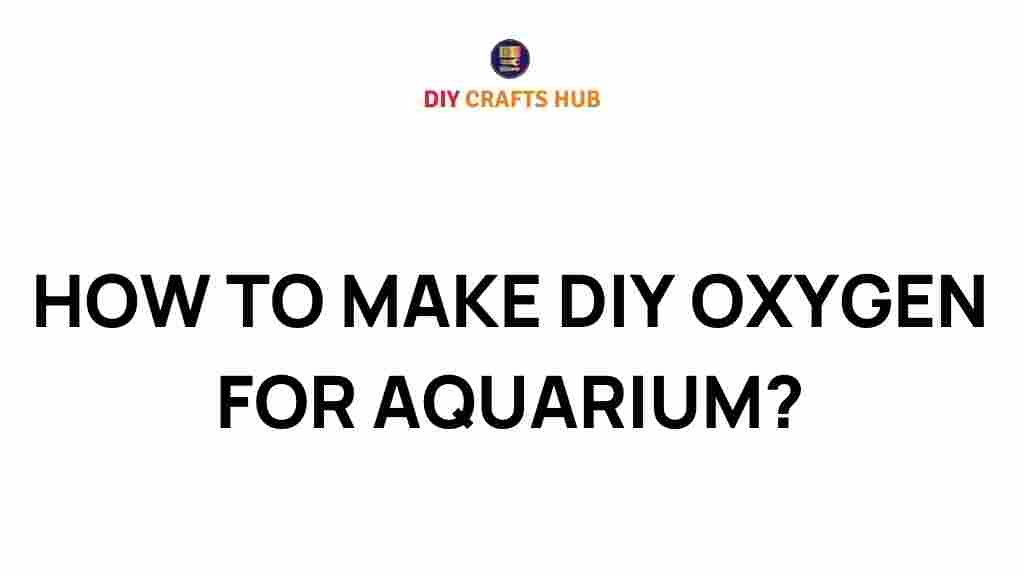DIY Oxygen: Transform Your Aquarium Like a Pro
Oxygen is a critical component for any thriving aquarium. It supports fish respiration, facilitates beneficial bacterial activity, and ensures overall aquatic health. If you’ve been struggling to maintain proper oxygen levels, creating a DIY oxygen generator is an affordable and effective solution.
This guide will walk you through the process of building and optimizing your own oxygen source, ensuring your aquatic life remains healthy and vibrant. By the end, you’ll master the art of DIY oxygen generation and understand how it transforms your aquarium ecosystem.
Why Oxygen Levels Matter in Aquariums
Maintaining appropriate oxygen levels in your aquarium is essential for the survival of fish, invertebrates, and plants. Low oxygen levels can lead to stress, illnesses, and even fatalities among aquatic inhabitants.
- Fish respiration: Fish absorb oxygen dissolved in water. Insufficient oxygen levels can leave them gasping for air.
- Bacterial activity: Beneficial bacteria require oxygen to break down waste and keep the water clean.
- Plant health: Aquatic plants need oxygen during their nighttime respiration cycle.
By crafting your own DIY oxygen generator, you can take control of your aquarium’s oxygen levels without relying solely on expensive equipment.
Tools and Materials You’ll Need
Before starting, gather the following materials to build your DIY oxygen system:
- A plastic bottle (1-2 liters)
- Airline tubing
- Air stone or diffuser
- Yeast
- Sugar
- Warm water
- Silicone sealant
- Drill or sharp tool for puncturing
These readily available materials ensure your DIY project remains cost-effective and efficient.
Step-by-Step Guide to DIY Oxygen Generation
Follow these steps to create your own DIY oxygen generator and revolutionize your aquarium care:
- Prepare the bottle:
Using a drill or sharp tool, make a hole in the bottle cap slightly smaller than the airline tubing diameter. Insert the tubing into the hole, ensuring a snug fit. Seal the area with silicone to prevent leaks.
- Create the solution:
Mix 2 cups of warm water, 2 tablespoons of sugar, and 1 teaspoon of yeast in the bottle. This mixture will produce carbon dioxide (CO2), which is essential for oxygen diffusion via the air stone.
- Attach the diffuser:
Connect the other end of the airline tubing to an air stone or diffuser. This device breaks the gas into fine bubbles for better oxygen dispersion.
- Position the system:
Place the bottle outside the aquarium and submerge the air stone in the tank. Ensure the tubing is long enough to prevent tipping or spills.
- Monitor and maintain:
Observe bubble production to ensure the system is functioning correctly. Replace the solution every 1-2 weeks to maintain efficiency.
Troubleshooting Your DIY Oxygen Generator
Even with a well-constructed system, challenges can arise. Here are common issues and solutions:
- No bubbles produced:
Check the yeast’s freshness or ensure the mixture is warm enough for fermentation. Replace old yeast if necessary.
- Leaks in the tubing:
Inspect the silicone seal around the cap and tubing. Apply additional sealant if leaks are detected.
- Bubbles are too large:
Verify that the air stone is not clogged or damaged. Replace it if necessary to create finer bubbles.
- Fish appear stressed:
Reduce CO2 production by lowering sugar content or adjusting bubble frequency. Always monitor your fish’s behavior closely.
Benefits of Using DIY Oxygen Generators
Implementing a DIY oxygen generator offers numerous advantages, including:
- Cost savings: DIY systems are far more affordable than commercial oxygen devices.
- Eco-friendly approach: Reducing reliance on manufactured devices minimizes your environmental footprint.
- Customizability: Tailor your system to suit your aquarium’s size and oxygen requirements.
Additionally, creating your own system provides a rewarding hands-on experience that enhances your knowledge of aquarium care.
Enhance Your Aquarium Setup
To further optimize your aquarium, consider complementing your DIY oxygen system with additional tools like filters and heaters. Learn more about creating the perfect habitat for your aquatic life by exploring our comprehensive aquarium setup guide.
For advanced oxygenation techniques, you may also find resources on Fishkeeping World invaluable.
Conclusion
Creating a DIY oxygen generator is an accessible and effective way to enhance your aquarium’s oxygen levels. By following this guide, you can ensure your aquatic environment thrives while enjoying the satisfaction of crafting your own solution.
With proper setup and regular maintenance, your aquarium will transform into a vibrant, healthy ecosystem that your fish and plants will love. Start your DIY journey today and see the difference it makes!
This article is in the category Home & Decor and created by DIYCraft Team
